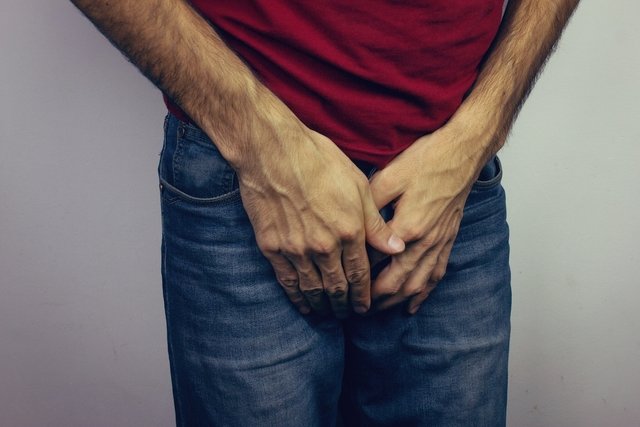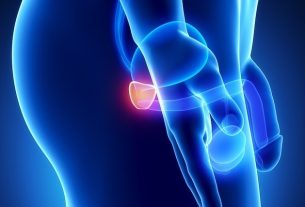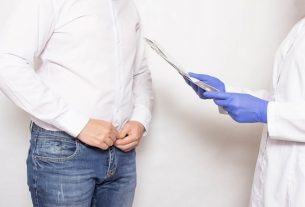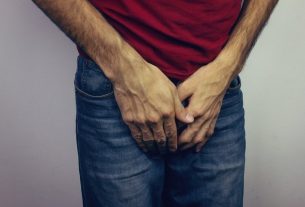Scrotal hernia, also known as inguinal-scrotal hernia, is a consequence of the development of an inguinal hernia, which is a bulge that appears in the groin resulting from a failure to close the inguinal canal. In the case of a scrotal hernia, this protrusion in the groin increases and moves towards the scrotum, which is the bag that surrounds and protects the testicles, causing swelling and pain in the area. Understand better how an inguinal hernia happens.
This type of hernia can appear in babies due to genetic factors or can appear in adults generally due to exertion, such as when there is an enlarged prostate requiring effort to urinate, obesity or excessive activities that involve carrying a lot of weight.
The diagnosis can be made by a surgeon and/or urologist through a specific physical examination and ultrasound or computed tomography. Treatment usually consists of surgery and the use of medications to relieve pain and discomfort, such as analgesics and anti-inflammatories.

Main symptoms
The symptoms of a scrotal hernia are similar to those of an inguinal hernia and can be:
- Protuberance in the groin area and scrotum;
- Pain or discomfort in the scrotum or groin when standing, carrying weight or bending over;
- Feeling of heaviness or pressure in the scrotal region when walking.
In babies, it is not always easy to observe the presence of a scrotal hernia, and it can be noticed when changing the diaper, where swelling in the scrotum can be seen, especially when the baby cries, due to the effort he makes.
If the scrotal hernia is not treated, it can lead to intestinal strangulation, in which there is no blood flow to the intestine, causing tissue death and symptoms such as vomiting, cramps, abdominal distension and absence of feces. Furthermore, scrotal hernia can lead to infertility, as sperm storage can be compromised. Learn about other causes of infertility.
How the diagnosis is made
The diagnosis is made by a clinical doctor, general surgeon or urologist based on the assessment of the symptoms reported by the man and a physical examination of the scrotum and groin region, in which the doctor also assesses the size of the hernia, for example.
To confirm the diagnosis, the doctor may request imaging tests, such as ultrasound or computed tomography. These exams are also important to differentiate scrotal hernia from hydrocele, which is a condition in which fluid accumulates in the testicles. Understand what a hydrocele is and how to treat it.
Scrotal hernia treatment
Treatment of a scrotal hernia is recommended by a general surgeon and/or urologist and, in most cases, involves surgery, which must be performed as quickly as possible, as soon as the diagnosis is confirmed, to avoid complications such as infertility or strangulation. intestinal.
Surgery to correct a scrotal hernia, also called herniorrhaphy, lasts about 1 hour and is performed under general or spinal anesthesia, but depending on the size of the hernia, only local anesthesia may be performed. In some cases, the doctor may even place a type of mesh/mesh to prevent the hernia from appearing again.
In addition, the doctor may recommend the use of anti-inflammatory or analgesic medications, such as ibuprofen and paracetamol, before and after surgery to relieve pain, as well as antibiotics after the surgical procedure to prevent infections. After surgery, it is important that men avoid lifting too much weight, sleep on their backs, increase their fiber intake, do not drive or remain sitting for a long time.
Possible causes
A scrotal hernia occurs due to the weakening of the muscles in the inguinal canal, causing parts of the intestine or other contents of the abdomen to move through this canal into the scrotum.
Furthermore, a scrotal hernia can arise due to genetic and congenital problems, that is, a man can be born with a scrotal hernia or this type of hernia can be caused by smoking, obesity and excessive activities that require carrying a lot of weight, in addition to It may also be related to prostate problems.
Bibliography
- TOWNSEND JR, Courtney M. et al. Sabiston treatise on surgery: the biological basis of modern surgical practice. 20.ed. Rio de Janeiro: Elsevier, 2019. 1092-1095.
- MARANHÃO, Débora DA et al. Giant inguinoscrotal hernia – case report. Arq Med Hosp Fac Cienc Med. Vol. 60. 152-155, 2015
- Inguino-scrotal herniation of the ureter containing stones. Hernia. 2016 Dec;20(6):887-890.. Vol.20, n.6. 887-890, 2016
- GRILLO JR, Lourival de P. et al. Incarcerated inguinoscrotal hernia. Fox With Saude Brasilia. Vol.5, n.1. 42-47, 2016

Sign up for our newsletter and stay up to date with exclusive news
that can transform your routine!
Warning: Undefined array key "title" in /home/storelat/public_html/wp-content/plugins/link-whisper-premium/templates/frontend/related-posts.php on line 12
Warning: Undefined array key "title_tag" in /home/storelat/public_html/wp-content/plugins/link-whisper-premium/templates/frontend/related-posts.php on line 13



